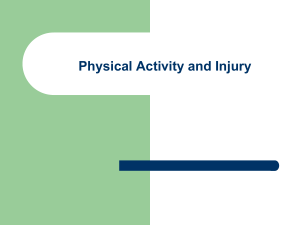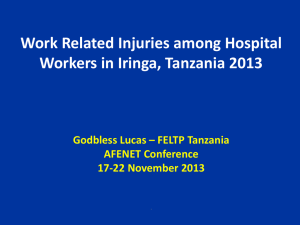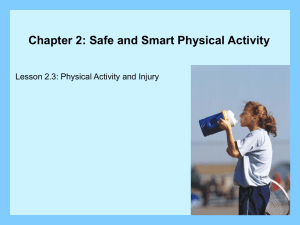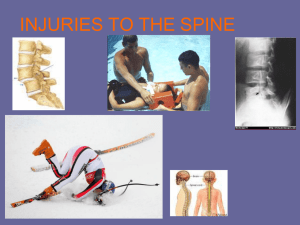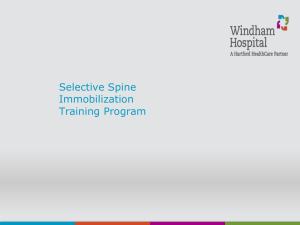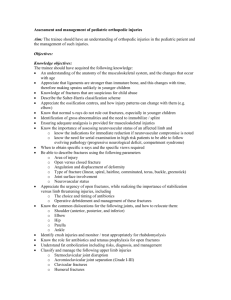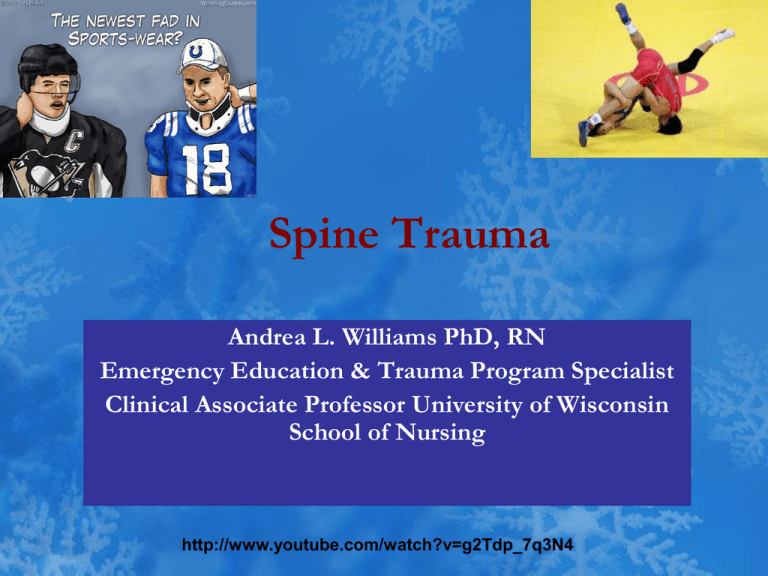
Spine Trauma
Andrea L. Williams PhD, RN
Emergency Education & Trauma Program Specialist
Clinical Associate Professor University of Wisconsin
School of Nursing
http://www.youtube.com/watch?v=g2Tdp_7q3N4
Introduction & Statistics
• 12,000-14,000 traumatic spinal cord
injuries (SCI’s) each year
• 4% - 5% of all head injuries are
associated with C1-C3 fractures
• 79% of SCI’s are male (41% 16-30 yrs old)
Spine & Vertebral Trauma
Sports
11%
Violence
19%
MVC's
49%
MVC's
Falls
Violence
Falls
21%
Sports
Types of Injuries
• Blunt
– Acceleration
– Deceleration
– Combination
• Penetrating
– Gunshot wound
– Stab wound
– Shrapnel
Mechanism of Injury
•
•
•
•
•
•
•
Hyperextension – Struck from rear
Hyperflexeion – Head on crash
Rotational - Spinning
Axial loading – Jumping or diving
Lateral bending – T-boned
Distraction – Sudden stop
Incorrectly applied safety restraints –
– Submarine
– Sudden flexion
Classification of Spinal Injuries
•
•
•
•
•
Sprains
Strains
Fractures
Dislocations
Sacral &
coccygeal
fractures
• Spinal cord
injuries (SCIs)
Sprains & Strains
• Hyperflexion Sprain
– Partial dislocation or subluxation of vertebral
joints
• Hyperextension Strain
– Low speed rear-end crash = whiplash
• Signs & Symptoms
– Muscle spasms of neck or back muscles
– Nonradiating aching soreness
– Bony deformity - Subluxation
• Treatment
– Cervical collar, heat, & analgesics
Fractures & Dislocations
• Most Frequently Injured Areas
– C5-C7
– C1-C2 Atlanto-occipital dislocation
Jefferson fx. Ondontoid or Hangman’s fx.
– T12-L2 Chance fx.
• Types of Fractures
– Simple – Stable/aligned – Linear spinous
or transverse process, facets or pedicle fx.
– Wedge/Compression – Stable - Stretch
posterior ligaments (Falls – T12-L1)
– Teardrop/Dislocations – Unstable –
Anterior/inferior corner pushed upwards
– Comminuted Burst Fx – Unstable
Sacral & Coccygeal Fractures
• S1 & S2 fractures are
common
– Loss of sensation & motor
functionto the perianal area
(Bladder sphincters)
• Tailbone fractures - falls
Complete Spinal Cord Injuries
Complete Injury/Lesion – Transection
–
–
–
–
Spinal fracture-dislocation
Complete loss of pain, pressure, proprioception
Motor paralysis below the level of the injury
Autonomic dysfuntion
•
•
•
•
•
•
Bradycardia
Hypotension
Priapism
Unable to sweat or shiver
Pokilothermy
Loss of bowels & bladder control
Incomplete SCIs
• Central Cord Syndrome
– Paralysis of the arms
– Sacral sparing – sensory & motor function
• Anterior Cord Syndrome
– ↓ sensation of pain & temperature below injury
– (+) light touch & proprioception
– Paralysis
• Brown-Séquard Syndrome
– Weakness in the extremities on the same side of injury
– Loss of temperature & pain on the opposite side of injury
• Posterior Cord Syndrome
– Motor function intact
– Loss of fine touch & pressure, proprioception, & vibration
below the level of the injury
1° Neurological Deficits
•
•
•
•
Concussion
Contusions
Transection
Structural damage of the
vertebrae or spinal column
• Interuption of the blood
supply
• Inadequate ventilation/O2
– C3 & above loss of phrenic innervation
– C3-C5 = Loss if diaphragmatic innervation
– C6-T8 = Loss of intercoastal function
2° Injury to the Spinal Cord
• Shock
– Hypovolemic
– Neurogenic
• Hot skin, slow HR, low BP
• Hypoxia
• Biochemical
– Edema
– Necrosis
Vertebral & SCI Assessment
•
•
•
•
•
Life Threats – ABC’s with immobilization
100% O2 , IV’s
History & MCI
c/o neck or back pain
Spontaneous movement – motor function &
strength in 4 extremities (T1, S1-S2, L5)
• Alteration in sensation – weakness, numbness,
light touch (more than 1 tract)
• Loss of bowel or bladder control
Dermatome Correlation
Nerve Root
Motor
Sensory
C3, C4
Shoulder shrug
Top of shoulder
C3-C5
Diaphragm
Top of shoulder
C5, C6
Elbow Flexion
Thumb
C7
Elbow Extension
Middle finger
C8, T1
Finger abduction
& adduction
Little finger
T4
Nipple
Dermatome Correlation
T10
Umbilicus
Sensory
L1, L2
Hip flexion
Inguinal crease
L3, L4
Quadriceps
Medial thigh/calf
LS
Great toe/foot
dorsiflexion
Lateral calf
S1
Knee flexion
Lateral foot
S1, S2
Foot plantar
flexion
S2-S4
Anal sphincter
tone
Perianal
Reflex Assessment
• *** Rarely evaluated prehospital
• May indicate autonomic nerve injury
–
–
–
–
–
Temperature control
Hypotension
Bradycardia
Priapism
Babinski sign
Neurogenic
Spinal Shock
Temporary Loss of sensory, motor & reflex function
Below the level of injury
↓
Flaccidity & Loss of reflexes
Duration is variable hours to weeks
Hypotensive, bradycardic, warm skin
Can’t sweat below level of injury
↓
Temporary – Usually less than 72 hours
Visual Assessment
• Diaphragmatic breathing
• Intercostal muscle function
• Body position
– Holdup position – C6 injury with arms flexed at
elbows and wrists
– Lying on face after fall – C2 (Ondontoid Fx.)
Palpation
• Step-off deformity
• Point tenderness over the
vertebrae
• Crepitus over the vertebrae
• Muscle spasms
Cervical, Brachial & Lumbae
Plexus Injuries
• Interlacing network of nerve fibers
• Injuries by stretching, contusion,
compression, trasection
– C3-C5 = Cervical Plexus
– C5-C8 & T1 = Brachial Plexus – Motor to
arm, hand, wrist
– L5-S4 = Lumbar Plexus – Posterior lower
body
Associated Injuries
• Drowning/near drowning
– Surfing
– Diving
– Water or jet skiing
• Distracting injuries
– Other systems
Concurrent Injuries
•
•
•
•
•
Closed head injuries
Facial injuries
Long bone fractures
Thoracic injuries
Abdominal injuries
Pre-Hospital Concerns
• Immobilization with rigid cervical
collar and Cervical Immobilization
Devices’s (CID’s)
Management of Vertebral or SCIs
• Prevent further injury with
immobilization
• Long board
• Complete spinal immobilization from
initial assessment to destination
• Head & neck in a neutral position unless
contraindicated
Immobilization Concerns
• No more tape & sandbags
• Do not remove the helmet in the
field
• Faster the time to definitive care in a
facility for SCI’s the better the
outcome





